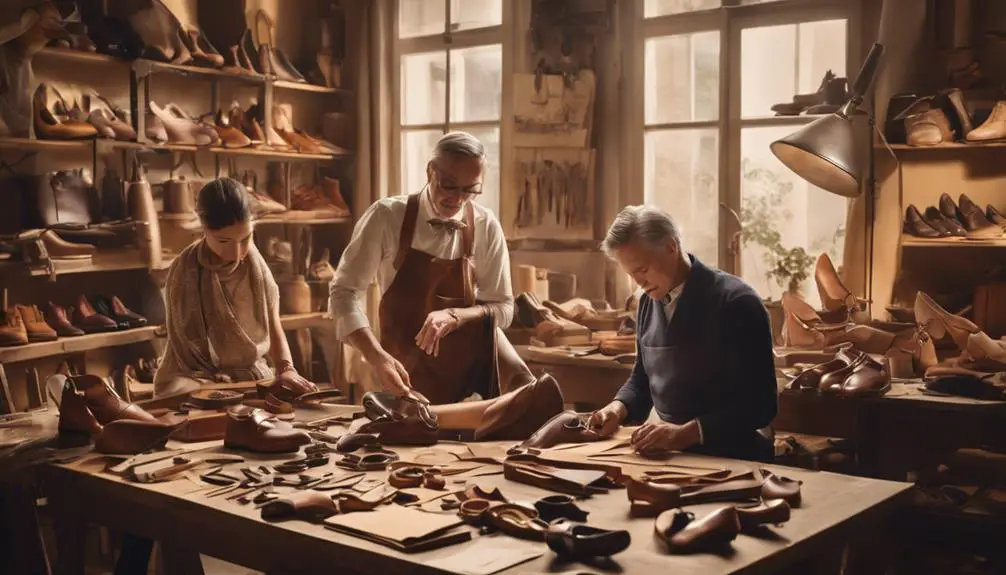The story of Salvatore Ferragamo begins in 1898 in Italy, where he was born into a large, poor family. His father was a shoemaker, sparking Salvatore's love for footwear. At just nine, he made his first pair of shoes. Moving to the U.S. in 1915, he opened a shoe-repair shop in California, soon attracting Hollywood's elite. By the 1920s, he founded Salvatore Ferragamo S.p.A., crafting iconic shoes like the wedge heel. His innovative spirit and dedication to quality established a luxury brand that thrives today, still led by his family. There's much more to discover about his incredible legacy!
Early Life and Influences

What shaped Salvatore Ferragamo's passion for footwear? Born in Bonito, Italy, in 1898, young Salvatore was the youngest of 14 children in a poor family. His father was a shoemaker, which sparked Salvatore's fascination with shoes from an early age. At just nine years old, he crafted his first pair of shoes for his sister's communion, a moment that marked the beginning of his lifelong journey into craftsmanship.
At 11, Salvatore took a significant step by studying shoemaking in Naples. This experience deepened his skills and passion for the art of shoe design.
After honing his craft, he emigrated to Santa Barbara, California, in 1915 to join his brothers. Here, he opened a shoe-repair workshop, quickly gaining a reputation as the "shoemaker to the stars." His talent attracted Hollywood stars who sought his custom designs, blending functionality with high fashion.
During his early years, Salvatore also worked in a shoe factory in Boston, where he encountered the limitations of machine-made shoes. This experience fueled his desire to create handcrafted footwear that offered both quality and comfort.
Salvatore's early exposure to his family's shoemaking tradition, combined with his formal education and experiences in America, laid a solid foundation for his future success. His journey from a small town in Italy to becoming a renowned name in the fashion industry highlights the power of passion and perseverance.
Journey to America
Salvatore Ferragamo's journey to America marked a pivotal chapter in his life, shaping his future as a renowned shoemaker. Emigrating to Santa Barbara, California, in 1915 at just 16 years old, he joined three of his brothers and quickly began to carve out his niche in the world of footwear.
Here's how his American adventure unfolded:
- Early Work Experience: Upon arrival, Ferragamo worked at the Plant Shoe Factory in Boston. There, he noticed the limitations of machine-made shoes, which sparked his passion for craftsmanship.
- Shoe-Repair Workshop: Shortly after, he opened a shoe-repair workshop in Santa Barbara. His skillful work soon caught the attention of early Hollywood stars, who became his loyal clients.
- Education and Growth: Ferragamo became a U.S. citizen in 1926 and furthered his education by studying anatomy at the Extension Division of the University of Southern California. This knowledge would later influence his designs.
- Hollywood Connections: His creative flair led him to design his first pair of shoes for movie stars, including the iconic cowboy boot for the film "The Diamond from the Sky," solidifying his presence in the budding fashion house scene.
Through hard work and unwavering dedication, Salvatore Ferragamo transformed his dreams into reality, laying the groundwork for a legacy that would endure for generations.
Rise to Prominence

Building on his initial success in Hollywood, Ferragamo quickly rose to prominence as a leading shoemaker, attracting the attention of the film industry's elite. His journey began in 1919 when he crafted custom cowboy boots for the movie "The Diamond from the Sky." This marked the start of his influential presence in Hollywood.
By 1925, he opened a store on Hollywood Boulevard, quickly earning the title of "shoemaker to the stars." Celebrities like Lottie and Mary Pickford became his loyal clients, drawn to his innovative designs. His commitment to quality and craftsmanship paralleled the ethos of luxury brands like Gucci's cultural impact, which also shaped the fashion landscape during this era.
As the 1930s rolled in, Ferragamo's reputation soared. His unique craftsmanship and eye for luxury footwear made him a favorite among the rich and famous. In 1926, he founded Ferra-Gamo Incorporated, laying down solid business foundations. Just a year later, he established Salvatore Ferragamo S.p.A., which allowed him to further expand his brand.
During World War II, Ferragamo continued to innovate by popularizing the wedge heel, using Sardinian cork for support. This design not only showcased his creativity but also cemented his status in the fashion world.
With each pair of shoes he crafted, Ferragamo elevated the art of shoemaking, capturing the hearts of countless celebrity clientele. His rise to prominence wasn't just about shoes; it was about creating a legacy that combined style, comfort, and luxury. Ferragamo's story reminds us that with passion and creativity, one can truly make a mark on the world.
Establishing the Brand
How did a small shoemaker from Italy become a global luxury brand? The story of Salvatore Ferragamo is one of passion, craftsmanship, and innovation. In 1926, he established Ferra-Gamo Incorporated in Hollywood, California, focusing on handmade shoes designed for the film industry's rising stars.
Just a year later, he founded Salvatore Ferragamo S.p.A. in Florence, Italy, where he blended artisanal craftsmanship with innovative design.
Ferragamo's first store opened in 1928, quickly capturing the attention of Hollywood celebrities and high-profile clientele. Here are key milestones that helped establish the brand:
- Handmade Shoes: Ferragamo's commitment to quality guaranteed that every pair of shoes was meticulously crafted, setting a high standard in the industry.
- Wedge Heel Design: During World War II, Ferragamo popularized the wedge heel, utilizing Sardinian cork to create stylish yet comfortable footwear amidst material shortages.
- Innovative Designs: His designs broke traditional molds, capturing the essence of modern luxury lifestyle while remaining true to Italian shoe craftsmanship.
- Global Expansion: The brand's reputation grew beyond Hollywood, paving the way for Ferragamo to expand into accessories like handbags, eyewear, and clothing.
Through his dedication to quality and innovative design, Salvatore Ferragamo laid the groundwork for a luxury lifestyle brand that resonates with elegance and sophistication today.
Legacy and Family Involvement

What happens to a brand when its founder passes away? In the case of Salvatore Ferragamo, the legacy didn't just continue—it thrived. After Salvatore's death in 1960, his wife, Wanda Ferragamo, stepped into leadership, transforming from a homemaker into a savvy businesswoman. She worked closely with their six children, affirming family involvement was central to the company's operations.
Wanda's strategic changes not only preserved the brand's essence but also fueled its growth. Among her children, Fiamma Ferragamo emerged as a key player, introducing the iconic Vara pumps in 1978. This design not only solidified the brand's status but also showcased the innovative spirit that defined the Ferragamo family business.
Today, the Ferragamo family remains at the helm, with Ferruccio Ferragamo as chairman and Leonardo Ferragamo overseeing luxury yacht operations. This leadership structure guarantees that the company's legacy is carefully preserved.
The Ferragamo brand, still family-owned as of November 2006, maintains strict employment rules, allowing only three family members to work within the company. This affirms a competitive environment that encourages collaboration and innovation.
In a world where many brands lose their identity after a founder's passing, the Salvatore Ferragamo company stands as a shining example of how family involvement can sustain and elevate a legacy. The commitment of Wanda and her children highlights the importance of passion and dedication in keeping a brand not only alive but thriving in a competitive market.




News on crypto regulations